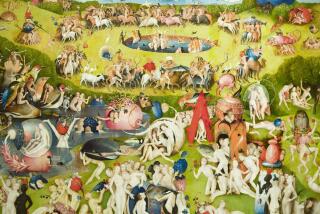Book review: ‘Gods Without Men’ by Hari Kunzru
Gods Without Men
A Novel
Hari Kunzru
Alfred A. Knopf: 373 pp., $26.95
“There are certain things you can’t look at directly. You need to trick them into revealing themselves,” a hedge fund entrepreneur named Cy Bachman explains in Hari Kunzru’s new novel “Gods Without Men.” It’s 2008, and he and his associate Jaz Matharu are looking at a silver coffee set in Manhattan’s Neue Galerie: The set is all that remains of a life that’s disappeared.
“When I come here,” Bachman continues, “I always find myself wondering what happened to the people who owned this.… There’s a tradition that says the world has shattered, that what once was whole and beautiful is now just scattered fragments. Much is irreparable, but a few of these fragments contain faint traces of the former state of things, and if you find them and uncover the sparks hidden inside, perhaps at last you’ll piece together the fallen world.”
“Gods Without Men” is all about such issues, the attempt to piece together a fallen world. Taking place across decades — even centuries — it moves from New York to Los Angeles to the Mojave to tell a series of overlapping stories, each of which has at its center the dilemma of what we can and cannot know.
If it has a central narrative, it may be the one about Jaz, his wife, Lisa, and their severely autistic 4-year-old son, Raj. But if the novel turns, in a certain sense, on Raj’s disappearance in the desert, it also has to do with a more amorphous sort of dislocation in which we exist—no matter what we believe or where we come from—at the intersection of two worlds.
“As Deighton lay by the fire, his head propped uncomfortably on his saddle,” Kunzru writes in a scene taking place in 1920, “many things seemed to collapse into one: the runner disappearing and reappearing instantaneously at his destination, the wandering Spanish friar, Coyote clinging to his reed and weaving his way into the Land of the Dead. Was this where Garcés had journeyed in his lost days? Was this where the running Indian had led them?”
Eighty-eight years later, Jaz and Lisa find themselves facing the same questions as reality turns inside out on them, and everything they once thought they could take for granted is revealed as a pernicious lie. “The lesson she’d learned,” Lisa reflects, “was that knowledge, true knowledge, is the knowledge of limits, the understanding that at the heart of the world, behind or beyond or above or below, is a mystery into which we are not meant to penetrate.”
This is the world we live in, or so we keep being reminded — often when we have allowed ourselves to forget, momentarily, the evanescence of the every day. It is all up for grabs all the time, and ahead of us, as Kunzru writes, “lay only a vast emptiness, an absence. There was nothing out there at all.” To confront these ideas is like staring into the abyss. Still, there are hints, whispers, not quite promises but (maybe) patterns, suggesting more at work than meets the eye.
It’s not really giving anything away to mention Raj’s disappearance in this novel; indeed, part of the power of the book is how little this matters in the end. Missing and reappearing children are a constant — from the little boy seen, phantom-like, with an old Indian in 1920 to the girl, Judy, who vanishes during the 1958 convocation of a UFO cult.
These kids become a set of echoes (what Kunzru calls “rhymes”), reverberating through both time and narrative. What happened to them? And when they return, as some do, are they the same as they were or rather some kind of “identical double,” a dream — or, possibly, a nightmare — fulfilled?
The same might be asked of all the characters in the novel, who are possessed, or taken over, less by their own intentions than by forces they can’t comprehend. For Jaz, this has to do with an investment model he helps create that, he begins to worry, may have caused the global economic meltdown; for Lisa, it is the daily rigor (horror?) of trying to deal with Raj.
As a consequence, when things finally come to a head in the Mojave, both are left to feel betrayed and responsible, as if the inexorable movement of the universe had something — some interest, some agenda — to do with them. The desert, in fact, functions like a magnet, or, perhaps, a vast cosmic receiver, drawing everything to itself. From 1775 to 1871 to 1947 to the broken culture of the 1960s, it is a landscape in which promises play out to nothing, “the secret place, the womb of the mystery.”
And yet, what is the nature of the mystery?
For Kunzru, it’s enough that it remains unresolved. In a prologue, he invokes Coyote, the great trickster of Native American mythology, cooking up meth in a desert lab. This juxtaposition — of the ancient and modern, of myth and madness — recurs throughout “Gods Without Men,” leaving us uncertain about where the legends end and reality begins. That all of the characters here are in a similar situation is the point: adrift in an indifferent universe, looking for symbols, for rhymes.
“If the world was made of signs, why couldn’t he read it?” Jaz wonders, a lament that speaks for everyone. When Lisa is asked, “What do you think of the theory that a wild animal, possibly a coyote, could have taken your child?” the question lingers, not just unanswered but unanswerable: A coyote of what kind? Has Raj slipped into a crack between worlds? Again, the novel makes us think it’s possible even as it casts doubt on that possibility. What do we do about this tension? How do we come to terms with our inability to know? “Shut the trapdoor,” Lisa thinks. “Draw the heavy bolt across it. There were places into which one shouldn’t trespass.”
“Gods Without Men” takes its title from Balzac: “In the desert, you see, there is everything and nothing… It is God without men.” Kunzru uses this as an epigraph, but its influence, I think, is more profound. What Balzac is saying is that only in such a landscape can we strip away “this cherished fiction, the fiction of the essential comprehensibility of the world.”
Only there can we confront, or even contemplate, the impassive face of God. “The face of a God,” declares Cy Bachman, talking about rhymes and echoes in the Neue Galerie. “What else would we be looking for?” Although, he acknowledges a moment later, “I think the real question is whether God believes in me.”
More to Read
Sign up for our Book Club newsletter
Get the latest news, events and more from the Los Angeles Times Book Club, and help us get L.A. reading and talking.
You may occasionally receive promotional content from the Los Angeles Times.










